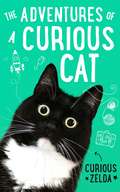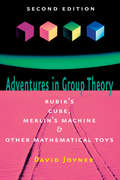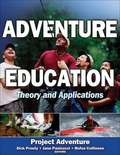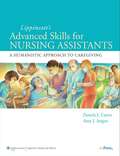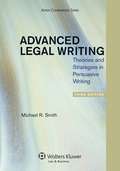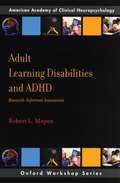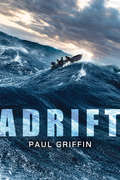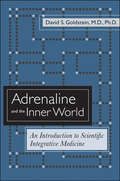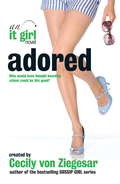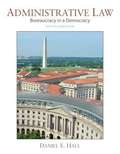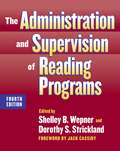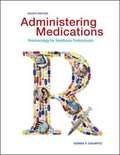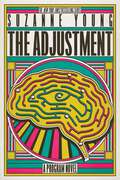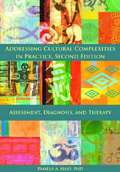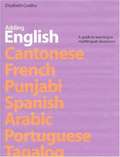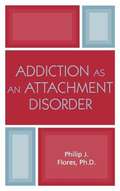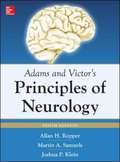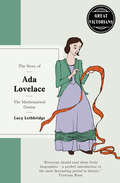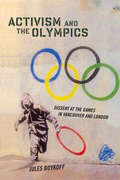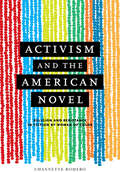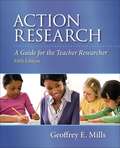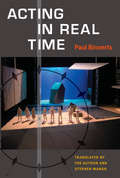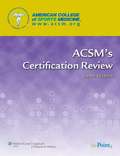- Table View
- List View
The Adventures of a Curious Cat: wit and wisdom from Curious Zelda, purrfect for cats and their humans
by Curious Zelda'A purrfect gift for a loved one with a special affinity for the feline''An absolute must for any cat lover''Curiosity is more than a desire to discover. It's a lifestyle, and a purrvilege. It's hours of observing a fly on the wall. It's entering the sock drawer just before it closes. It's sniffing the lampshade one more time . . .'Such is the wisdom of Curious Zelda: social media star, agony aunt, yoga teacher, cat. In The Adventures of a Curious Catshe gives insight into her view of the world and dispenses unparalleled wisdom. Zelda explains, in her unique voice, how to handle humans, how to communicate with furniture, and most importantly how to live a life curiously. It's the ultimate self-help guide for any cat, or indeed, their human.
Adventures in Group Theory: Rubik's Cube, Merlin's Machine, and Other Mathematical Toys
by David JoynerThis updated and revised edition of David Joyner’s entertaining "hands-on" tour of group theory and abstract algebra brings life, levity, and practicality to the topics through mathematical toys.Joyner uses permutation puzzles such as the Rubik’s Cube and its variants, the 15 puzzle, the Rainbow Masterball, Merlin’s Machine, the Pyraminx, and the Skewb to explain the basics of introductory algebra and group theory. Subjects covered include the Cayley graphs, symmetries, isomorphisms, wreath products, free groups, and finite fields of group theory, as well as algebraic matrices, combinatorics, and permutations.Featuring strategies for solving the puzzles and computations illustrated using the SAGE open-source computer algebra system, the second edition of Adventures in Group Theory is perfect for mathematics enthusiasts and for use as a supplementary textbook.
Adventure Education: Theory and Applications
by Dick Prouty Jane Panicucci Rufus CollinsonAdventure Education: Theory and Applicationsallows students to -get a broad view of adventure education and programming; -explore the role of games, low- and high-element courses, and outdoor pursuits in adventure education; -use key concepts, student activities, and Web-based research to enhance the learning process; -employ real-world examples to explore strategies for adventure education in a variety of settings; and -learn core skills for effective facilitation and leadership preparation in adventure programming. With Adventure Education: Theory and Applications, adventure education enters the educational mainstream. This comprehensive text is ideal for introductory adventure courses in a variety of college departments and as a reference for professionals in the field. Project Adventure, a leader in the field of facilities-based adventure learning, teams up with leading adventure educators and professionals to provide a broad view of adventure education and programming. Together, they present the foundational theories and applications of adventure education. In doing so, they -explore the role of games, low- and high-element courses, and outdoor pursuits in adventure education; -cover the core skills for effective facilitation and leadership preparation; -include student-friendly features, such as key concepts, summaries, student activities, additional readings, and Web-based research to meet students' levels of experience and enhance the easy delivery of the course; and -recommend strategies for adventure education and programming based on real-world examples that connect to a variety of recreational, educational, therapeutic, and community settings. Part Ipresents the history of adventure education as well as the numerous theories and philosophies that have informed its development. It explores the world of adventure in education, health care, and therapeutic, corporate, and school settings. It also provides an overview of adventure organizations and career options, which is helpful to students who are interested in pursuing the study of adventure. Part IIoutlines the technical and pedagogical skills needed for facilitating adventure experiences. Part IIIdescribes each adventure component, explaining how they work in the educational process. It covers facilities-based pursuits such as games, cooperative activities and initiatives, and challenge courses as well as outdoor pursuits. Some sample activities and many additional resources are provided. The final chapter covers models for programming adventure in educational, therapeutic, corporate, and community settings. For students who select careers in other fields, the leadership and team skills learned through Adventure Education: Theory and Applicationswill serve them well in their future workplaces. For students who do go into adventure education, this text is their guide for finding their own paths in the field.
Advanced Skills For Nursing Assistants: A Humanistic Approach To Caregiving
by Lippincott Williams WilkinsThis text builds on the basic concepts and skills that the nursing assistant has already mastered. Recognizing that the students using this text have already completed their basic nursing assisting training and may have already been working in the profession, this text does not repeat information that is part of the basic nursing assistant training. Rather, this textbook is meant to be used in conjunction with, or as a follow-up to, a "basic" nursing assistant textbook, such as Lippincott's Textbook for Nursing Assistants.
Advanced Legal Writing: Theories and Strategies in Persuasive Writing (Third Edition)
by Michael R. SmithWith a practical focus on persuasive writing strategy, Michael R. Smith identifies and explores three processes of persuasive writing--logos, pathos, and ethos--and provides a thorough introduction to the elements of rhetorical style. Using detailed how-to guides and plenty of examples, the author's distinctive approach to persuasive writing examines: technical aspects of rhetorical style: metaphor, literary allusion, figures of speech, and graphic design three basic processes of persuasive legal writing strategy: Logos: logic and rational argument Pathos: value-based argument Ethos: establishing credibility interdisciplinary contributions to persuasive writing from fields such as cognitive psychology, classical rhetoric, and morality theory effective strategies that extend beyond the trial or appellate brief to a broad range of documents and settings In the Second Edition, the reader will find: a new organization that puts a greater emphasis on practice and relatively less on theory for each of the three processes of persuasive writing strategy a new six-Part organization: I. Introduction II. Logos Strategies III. Pathos Strategies IV. Ethos Strategies V. Rhetorical Style VI. The Ethics and Morality of Persuasion coverage of new developments in cognitive psychology, Pathos persuasion, and the role of metaphor in persuasive legal writing. the same manageable length For a complete examination of the technique and strategy behind persuasive writing, Smith's text strikes the right balance of depth and scope for upper-level legal writing courses.
Adult Learning Disabilities and ADHD: Research-Informed Assessment
by Robert L. MapouThe book provides scientific and practical guidance on assessing learning disabilities and ADHD in adults. Topics include definitions of disability, assessment, and management approaches (from medications and therapy to educational and workplace accommodations), and assistive technology and software. The book is aimed at clinical neuropsychologists and clinical psychologists who are involved in the assessment and management of adults with learning disabilities and ADHD.
Adrift
by Paul GriffinFrom critically acclaimed writer Paul Griffin comes a fast-paced young adult novel about five very different teens lost at sea with no one to count on but each other.Matt and John are best friends working out in Montauk for the summer. When Driana, JoJo and Stef invite the boys to their Hamptons mansion, Matt and John find themselves in a sticky situation where temptation rivals sensibility. The newfound friends head out into the Atlantic after midnight in a stolen boat. None of them come back whole, and not all of them come back.Worlds collide when the group ventures out to sea aboard an antique ship that Stef sneaks out from her dad's dock. As the waves rise and the fragile vessel weakens, things go horribly wrong. Adrift at sea for days, who will have what it takes to survive?
Adrenaline and the Inner World: An Introduction to Scientific Integrative Medicine
by David S. GoldsteinThis accessible work is the first in more than seventy-five years to discuss the many roles of adrenaline in regulating the "inner world" of the body. David S. Goldstein, an international authority and award-winning teacher, introduces new concepts concerning the nature of stress and distress across the body's regulatory systems. Discussing how the body's stress systems are coordinated, and how stress, by means of adrenaline, may affect the development, manifestations, and outcomes of chronic diseases, Goldstein challenges researchers and clinicians to use scientific integrative medicine to develop new ways to treat, prevent, and palliate disease. Goldstein explains why a former attorney general with Parkinson disease has a tendency to faint, why young astronauts in excellent physical shape cannot stand up when reexposed to Earth's gravity, why professional football players can collapse and die of heat shock during summer training camp, and why baseball players spit so much. Adrenaline and the Inner World is designed to supplement academic coursework in psychology, psychiatry, endocrinology, cardiology, complementary and alternative medicine, physiology, and biochemistry. It includes an extensive glossary.
Adored: An It Girl Novel
by Cecily Von ZiegesarJenny Humphrey's time at Waverly Academy has had its ups and downs - from making enemies of the most popular girl at school to stealing her room mate's boyfriend. But now everything has changed - Jenny, Tinsley, Callie and Brett have put their differences behind them to jointly rule over Waverly Academy - but how long can peace last?
Administrative Law: Bureaucracy In A Democracy (Sixth Edition)
by Daniel E. HallAdministrative Law: Bureaucracy in a Democracy, Sixth Edition, covers the constitutional and procedural dimensions of governmental agencies, including delegation, rulemaking, adjudications, investigations, freedom of information, liabilities of governments and their employees, judicial review, and other considerations, such as the concept of fairness. Instructor resources include an Instructor's Manual, PowerPoint lecture slides, and a Test Bank. Teaching and Learning Experience: Examines administrative law in the context of accountability and the prevention of abuse Assists students in critical thinking and case analysis by including case excerpts Provides practical knowledge of administrative agencies and the laws that govern their behavior
The Administration And Supervision Of Reading Programs
by Dorothy S. Strickland Shelley B. WepnerOffering specific guidelines that literacy leaders can use to improve their programs, this text covers selecting materials, assessing the quality of teachers, providing staff development, working with different types of learners, and incorporating writing and technology.
Administering Medications: Pharmacology for Healthcare Professionals, Eighth edition.
by Donna F. GauwitzAdministering Medications: Pharmacology for Healthcare Professionals is designed to teach the safe administration of medications to healthcare students. The organization of the chapters primarily by body systems allow students and instructors to build a knowledge base that starts with the fundamentals of medication administration and progresses through the drugs frequently used to treat most commonly found disease of the associated body system. The text's many features help break down the various aspects of drug administration, allowing the student to gain a full understanding of when and how to administer medications.
The Adjustment (Program #5)
by Suzanne YoungTwo teens struggle to recapture their love after one of them goes through The Program in this gut-wrenching fifth book in Suzanne Young&’s New York Times bestselling series—now with a reimagined look.Tatum Masterson never went through The Program. She never had her memory stripped, never had to fight to remain herself. But Weston, her longtime boyfriend and love of her life, did. Even as he was taken by handlers, Tatum hoped he&’d remember her somehow—that their love would be strong enough. It wasn&’t. Like all returners, Weston comes back a blank canvas. The years he and Tatum spent together are forgotten, as well as the week he mysteriously disappeared before The Program came for him. Still, Tatum fights to get Weston to remember her. They start to build a new love, then they hear about the Adjustment—a new therapy that implants memories from a donor. Despite the risks, Tatum donates her memories from their time together so Weston can remember what he lost. But memories are all a matter of perspective. Weston only has one side of their love story, and his emotions don&’t match his borrowed experiences. The heartbreaking, mind-bending discrepancy slowly unravels him, causing more damage than The Program itself. As their new life together feels more untenable, Tatum will have to decide if she loves Weston enough to let him go.
Addressing Cultural Complexities in Practice: Assessment, Diagnosis, and Therapy (Second Edition)
by Pamela A. HaysMeant for counsellors, clinicians, and mental health professionals, the author helps therapists recognise and understand the cultural influences which define and drive each of us.
Adding English: A Guide to Teaching in Multilingual Classrooms
by Elizabeth CoelhoAdding English: A Guide to Teaching in Multilingual Classrooms is a comprehensive source of ideas of advice for enhancing the learning of all students in all subject areas and at all grade levels.
Addiction as an Attachment Disorder
by Philip FloresFrom the Foreword: "Addiction is a disorder in self-regulation. Individuals who become dependent on addictive substances cannot regulate their emotions, self-care, self-esteem, and relationships. In this monumental and illuminating text Philip Flores covers all the reasons why this is so. But it is the domain of interpersonal relations that he makes clear why individuals susceptible to substance use disorders (SUDs) are especially vulnerable. His emphasis on addiction as an attachment disorder is principally important because he provides extensive scholarly and clinical insights as to why certain vulnerable individuals so desperately need to substitute chemical solutions and connections for human ones. The strength of Flores's paradigm of addiction as an attachment disorder is that it is a theory that effectively and wisely guides treatment, but at the same time, when properly implemented or practiced, the treatment resonates with and further enhances the theory. Flores's work here is an extraordinary one because, in parsimonious and clear language, he makes a major contribution to the literature and practice of effective psychotherapy in general and effective psychotherapy for the addictions in particular. He fills in all the gaps between theory and practice covering wide and ranging issues of what practice and empirical findings have to teach about the critical ingredients of AA, group therapy, and individual psychotherapy. This is a job well done because it helps students and experienced clinicians alike to always be mindful of how they bring their humanity to the distress and suffering of others. His theory of addiction as an attachment disorder makes it particularly clear how especially important this is for those suffering with addictive disorders. " —Edward J. Khantzian, M.D., clinical professor of psychiatry, Harvard Medical School
Adaptive Technologies for Training and Education
by Paula J. Durlach Alan M. LesgoldThis edited volume provides an overview of the latest advancements in adaptive training technology. Intelligent tutoring has been deployed for well-defined and relatively static educational domains such as algebra and geometry. However, this adaptive approach to computer-based training has yet to come into wider usage for domains that are less well defined or where student-system interactions are less structured, such as during scenario-based simulation and immersive serious games. In order to address how to expand the reach of adaptive training technology to these domains, leading experts in the field present their work in areas such as student modeling, pedagogical strategy, knowledge assessment, natural language processing and virtual human agents. Several approaches to designing adaptive technology are discussed for both traditional educational settings and professional training domains. This book will appeal to anyone concerned with educational and training technology at a professional level, including researchers, training systems developers and designers.
Adams and Victor's Principles of Neurology (Tenth Edition)
by Allan Ropper Martin Samuels Joshua KleinThe definitive text on the full-spectrum of neurology for decades, Adams and Victor's provides the treatment and management strategies needed to confidently handle both common and rare neurologic conditions. Written in a clear, consistent tone, this classic resource will meet the needs of the seasoned professional or the aspiring clinician. Written from the perspective of the general neurologist, Adams and Victor's has been hailed as the most detailed, thorough, and authoritative text available on the subject. Adams and Victor's Principles of Neurology, Tenth Edition describes the various categories of neurologic disease and the main diseases that constitute each. Each subject is introduced by a detailed discussion of the symptoms and signs of disordered nervous function, their anatomic and physiologic bases, and their clinical implications. Adams and Victor's Principles of Neurology is logically divided into six parts: The Clinical Method of Neurology Cardinal Manifestations of Neurologic Disease Growth and Development of the Nervous System in the Neurology of Aging Major Categories of Neurologic Disease Diseases of the Spinal Cord, Peripheral Nerve, and Muscle Psychiatric Disorders The Tenth Edition is highlighted by the welcome addition of full-color photographs, expanded coverage of important subspecialties, and an increased number of tables and figures. Edition after edition, Adams and Victor's has stayed true to its original mission: to provide a well-written, readable text emphasizing a disciplined presentation of clinical data and lucid descriptions of underlying disease processes.
Ada Lovelace: Computer Wizard of Victorian England
by Lucy LethbridgeDaughter of the famous romantic poet Lord Byron, Ada Lovelace was a child prodigy. Brilliant at maths, she read numbers like most people read words.Lady Byron wanted Ada to be as unlike her father as possible. Ada grew up surrounded by an army of tutors who taught her every subject every waking moment, except for poetry.In 1843 Ada came to the attention of Charles Babbage, a scientist and inventor who had just built a miraculous machine called the ‘Difference Engine’. Ada and Mr Babbage started working together – a perfect partnership which led to the most important invention of the modern world: the computer! Short Books is re-releasing some of its finest writing as a newly designed series of six children’s biographies called The Great Victorians. These are entertaining and engaging stories of some of history’s most fascinating characters. They tell history in a novelistic, engaging way, a halfway house between storybooks and traditional history. There is abundant humour and drama too.With beautifully designed covers these books will catch the eyes of parents as well as children. Also published in a highly collectable set.
Acute Pain Management
by Henry Mcquay Raymond S. Sinatra Oscar A. de Leon-Casasola Brian Ginsberg Eugene R. ViscusiThis textbook is written as a comprehensive overview of acute pain management. It is designed to guide clinicians through an impressive array of different options available to them and to patients. There has been a flurry of interest in the extent to which acute pain can become chronic pain, and how we might reduce the incidence of such chronicity. This overview covers a wide range of treatments for pain management, including the anatomy of pain pathways, the pathophysiology of severe pain, pain assessment, therapeutic guidelines, analgesic options, organization of pain services, and the role of anesthesiologists, surgeons, pharmacists, and nurses in providing optimal care. It also discusses the use of patient-controlled analgesia and how this may or may not be effective and useful.
Activism and the Olympics
by Jules BoykoffThe Olympics have developed into the world's premier sporting event. They are simultaneously a competitive exhibition and a grand display of cooperation that bring together global cultures on ski slopes, shooting ranges, swimming pools, and track ovals. Given their scale in the modern era, the Games are a useful window for better comprehending larger cultural, social, and historical processes, argues Jules Boykoff, an academic social scientist and a former Olympic athlete. In "Activism and the Olympics," Boykoff provides a critical overview of the Olympic industry and its political opponents in the modern era. After presenting a brief history of Olympic activism, he turns his attention to on-the-ground activism through the lens of the Vancouver 2010 Winter Olympics and the 2012 Summer Olympics in London. Here we see how anti-Olympic activists deploy a range of approaches to challenge the Olympic machine, from direct action and the seizure of public space to humor-based and online tactics. Drawing on primary evidence from myriad personal interviews with activists, journalists, civil libertarians, and Olympics organizers, Boykoff angles in on the Games from numerous vantages and viewpoints. Although modern Olympic authorities have strived--even through the Cold War era--to appear apolitical, Boykoff notes, the Games have always been the site of hotly contested political actions and competing interests. During the last thirty years, as the Olympics became an economic juggernaut, they also generated numerous reactions from groups that have sought to challenge the event's triumphalism and pageantry. The 21st century has seen an increased level of activism across the world, from the Occupy Movement in the United States to the Arab Spring in the Middle East. What does this spike in dissent mean for Olympic activists as they prepare for future Games?
Activism and the American Novel: Religion and Resistance in Fiction by Women of Color
by Channette RomeroSince the 1980s, many activists and writers have turned from identity politics toward ethnic religious traditions to rediscover and reinvigorate their historic role in resistance to colonialism and oppression. In her examination of contemporary fiction by women of color—including Toni Morrison, Ana Castillo, Toni Cade Bambara, Louise Erdrich, and Leslie Marmon Silko—Channette Romero considers the way these novels newly engage with Vodun, Santería, Candomblé, and American Indian traditions. Critical of a widespread disengagement from civic participation and of the contemporary novel’s disconnection from politics, this fiction attempts to transform the novel and the practice of reading into a means of political engagement and an inspiration for social change.
Action Research (Fifth Edition)
by Geoffrey E. MillsThe book provides qualitative and quantitative guidelines for Action Research, to future educators via numerous concrete illustrations, study sites, videos and other supplemental materials.
Acting in Real Time
by Paul BinnertsActing in Real Time by renowned Dutch director and acting teacher Paul Binnerts describes his method for Real-Time Theater, which authorizes actors to actively determine how a story is told---they are no longer mere vehicles for delivering the playwright's message or the director's interpretations of the text. This level of involvement allows actors to deepen their grasp of the material and amplify their stage presence, resulting in more engaged and nuanced performances. The method offers a postmodern challenge to Stanislavski and Brecht, whose theories of stage realism dominated the twentieth century. In providing a new way to consider the actor's presence on stage, Binnerts advocates breaking down the "fourth wall" that separates audiences and actors and has been a central tenet of acting theories associated with realism. In real-time theater, actors forgo attempts to become characters and instead understand their function to be storytellers who are fully present on stage and may engage the audience and their fellow actors directly. Paul Binnerts analyzes the ascendance of realism as the dominant theater and acting convention and how its methods can hinder the creation of a more original, imaginative theater. His description of the techniques of real-time theater is illuminated by practical examples from his long experience in the stage. The book then offers innovative exercises that provide training in the real-time technique, including physical exercises that help the actor become truly present in performance. Acting in Real Time also includes a broad overview of the history of acting and realism's relationship to the history of theater architecture, offering real-time theater as an alternative. The book will appeal to actors and acting students, directors, stage designers, costume designers, lighting designers, theater historians, and dramaturgs.
ACSM's Certification Review (3rd edition)
by Khalid W. Bibi Michael G. NiederpruemACSM's Certification Review is a review manual for candidates wanting an ACSM credential including ACSM Certified Health Fitness Specialist (HFS), the ACSM Clinical Exercise Specialist (CES), and the ACSM Certified Personal Trainer (CPT) certifications. Content is based on the Knowledge, Skills, and Abilities (KSAs) found in ACSM's Guidelines for Exercise Testing and Prescription.
